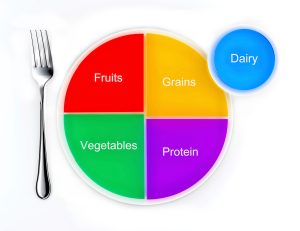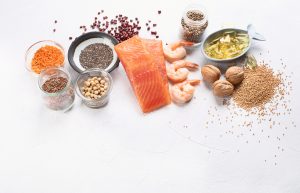 Eating healthy is important at all stages of life, but perhaps especially as we grow older and our bodies need all the advantages we can give them. When we’re younger, we can get away with paying less attention to the recommended nutrition guidelines and overindulging here and there, but aging bodies need a little more TLC.
Eating healthy is important at all stages of life, but perhaps especially as we grow older and our bodies need all the advantages we can give them. When we’re younger, we can get away with paying less attention to the recommended nutrition guidelines and overindulging here and there, but aging bodies need a little more TLC.
The good news is that eating healthy doesn’t have to be hard, and it doesn’t have to be boring.
In fact, eating a more balanced and varied diet can expand your culinary horizons. And taking better care about what you eat has so many benefits: more energy, healthier weight, stronger bones, more resilient immune system, happier outlook, and fewer trips to the doctor, just to name a few.
But what does a healthy diet look like for someone 60 or older? What should you avoid, what should you eat more often, and how do you know when to talk to your doctor about a nutrition concern?
Here’s an overview of some of the main considerations to keep in mind when building healthy eating habits for yourself or a loved one. (We’ve also included links to additional resources.)
Why Nutrition Needs Change
Before we get into the do’s and don’ts of healthy eating in the golden years, let’s talk a little about why our diets need to change as we get older.
The short answer is simple: as we age, our bodies change; and we need to adjust our nutrition to accommodate those changes.
Some of the changes we might experience include:
- Slower metabolism
- Lower nutrient absorption
- Less active lifestyle
- Medical conditions
- Reduced appetite
- Less independence
Each of these factors affects us in a different way. A slower metabolism, for instance, means that we require fewer calories each day. Our bodies’ reduced ability to absorb calcium might necessitate an increase in calcium-rich foods. A diagnosis of high blood pressure might require that we limit our sodium intake. And if we’re facing challenges managing day-to-day tasks, that can force us to rely more heavily on prepared and frozen meals that may not be as nutrient-rich as homemade, whole food fare.
Healthy Eating Tips for the Over-60 Set
 Learn what a healthy plate looks like.
Learn what a healthy plate looks like.
Most of us grew up with the Food Pyramid, but the USDA released a new guide that has replaced that old standby. MyPlate is a simplified way to illustrate what the building blocks of a healthy diet should look like on your plate.
The MyPlate website includes a lot of great educational resources and planning tools including quizzes and shopping lists, printable materials and videos, and a large collection of healthy recipes. There’s even a MyPlate app and an Alexa integration!
Stick to recommended portion sizes.
How much you should eat depends on several variables including your age, your height and weight, your metabolism, and your activity level. The combination of these factors determines how many calories you should consume in a day. It can be tricky, however, to manage your portion sizes.
First, it’s important to remember that portion sizes are different from serving sizes. A serving size is the amount that appears on a nutrition label. A portion size is, simply, how much you choose to eat of a given food. Sometimes, the portion size and serving size will be the same. Sometimes, they will be very different.
For example, the serving size on a box of pasta might be 1/2 cup, but your portion size—what you actually eat—might be 2 cups, meaning that you have actually eaten 4 servings of pasta.
Build a diet that incorporates all the nutrients you need.
As we age, it’s more important than ever to make sure our bodies are getting all the nutrients they need to keep us healthy and strong. Here are a few nutrients that are especially important for older folks.
Calcium: While it’s true that calcium is important to maintain bone strength, it also helps with muscle and nerve health. Foods that provide calcium include certain vegetables (kale, broccoli, spinach, okra, and others).
Iron: Iron is important for healthy blood, and for moving oxygen around your body. While lean meats, chicken, and seafood are the most commonly known sources of iron, many vegetables and legumes also provide a healthy dose of this important nutrient: kidney beans and lentils, spinach, nuts, raisins, and more.
Fiber: As we age, digestion becomes increasingly important. Fiber helps keep our digestive systems healthy and functioning. Examples of foods that provide a lot of fiber include chickpeas, whole wheat pastas, berries, artichoke hearts, and avocados.
 Omega 3: Omega 3 fatty acids are star players when it comes to helping prevent serious health issues like heart disease, stroke, and lupus. They may even help combat certain cancers. Foods that deliver this life-saving nutrient include fatty seafood options (tuna, salmon, etc.), walnuts, plant oils (canola, soybean, flaxseed). Some brands of common foods like eggs, yogurt, juice, and milk are fortified with Omega 3, providing an additional way to get this nutrient into your diet.
Omega 3: Omega 3 fatty acids are star players when it comes to helping prevent serious health issues like heart disease, stroke, and lupus. They may even help combat certain cancers. Foods that deliver this life-saving nutrient include fatty seafood options (tuna, salmon, etc.), walnuts, plant oils (canola, soybean, flaxseed). Some brands of common foods like eggs, yogurt, juice, and milk are fortified with Omega 3, providing an additional way to get this nutrient into your diet.
Vitamin C: It’s not just for scurvy! Versatile Vitamin C helps prevent cell damage, create collagen, and protect the immune system. You can find it in citrus fruits, of course, but also in a lot of other fruits and vegetables including strawberries, bell peppers, potatoes, cantaloupe, cauliflower, and many more.
Vitamin D: This vitamin is important for older folks because it aids the absorption of calcium. It also plays a role in maintaining a healthy immune system, strong muscles, and nerve health. In addition to dairy products like milk and yogurt, you can also find Vitamin D in fatty fish (tuna, swordfish, salmon). And it’s also available, to a lesser extent, in some mushrooms, egg yolks, and cheese.
Plan your meals ahead.
There’s a lot to be said for planning ahead. Even on the best days it can be a challenge to decide what to eat, make sure you have the ingredients on hand, and then prepare the dish. The whole process can become more stressful.
You can make things easier for yourself or a loved one by choosing all your meals for a week at a time. When you make these decisions all at once, it’s easy to then shop efficiently so you have everything you need. Planning ahead also makes it easier to ensure that you’re covering all the important food groups and nutrients while at the same time keeping things interesting.
Be careful about packaged foods.
Not every meal has to be home cooked, but be wary of succumbing to the siren song of packaged foods and frozen meals. While these convenience options are great in a pinch, heavy reliance on them can sabotage your efforts to improve overall nutrition and health.
Don’t forget to hydrate!
Finally, don’t forget the power of good, old H2O. Staying hydrated is critically important to our health, but it’s easy to overlook. The rule of thumb recommends drinking eight 8-ounce glasses of water each day, but remember that you can mix up your fluids to meet that quota. Tea, 100% fruit juice, and other healthy drink options all contribute to keeping you hydrated. Just be careful not to get in the habit of drinking anything that has a lot of sugar, like soda or many commercial juices.
Other Considerations
In addition to being mindful about what you eat, there are a few other considerations that are important to maintaining overall health and nutrition.
Follow food safety guidelines.
Paying attention to expiration dates and ensuring proper food handling and preparation goes a long way toward ensuring food safety. And taking these precautions is especially important for those who tend to have a more compromised immune system, and are therefore more vulnerable to foodborne illnesses. You can learn more about best practices at FoodSafety.org.
Stay active.
 While eating the right foods is one of the main ways to stay healthy as we age, it’s also incredibly important to keep moving. Including some physical activity and exercise in your daily routine is a reliable way to help maintain strength, balance, a healthy weight, and overall wellbeing. Movement has also been shown to alleviate the symptoms of many health issues that tend to crop up in later years, including arthritis, diabetes, and high blood pressure.
While eating the right foods is one of the main ways to stay healthy as we age, it’s also incredibly important to keep moving. Including some physical activity and exercise in your daily routine is a reliable way to help maintain strength, balance, a healthy weight, and overall wellbeing. Movement has also been shown to alleviate the symptoms of many health issues that tend to crop up in later years, including arthritis, diabetes, and high blood pressure.
The good news is that staying active doesn’t have to involve boring or difficult exercise routines. An active lifestyle is simply one that includes some movement. That might be riding a stationary bike or power walking, or maybe doing some yoga, taking the dog for an evening constitutional, working in the garden, or playing with the grandkids. Even running the vacuum or raking up some leaves counts!
Consider supplements.
Even those of us with the best intentions may find it difficult to consistently get all the nutrients we need from the food we eat. If this is a concern, talk to your doctor about the possibility of incorporating vitamin supplements into your daily routine.
 Live a happier, healthier life by making smart choices about what you eat.
Live a happier, healthier life by making smart choices about what you eat.
Eating healthy can also be something you tackle with friends or family. Plan healthy meals together, and cheer each other on as you try new foods, exercise the will power needed to avoid old habits, and experience the benefits of eating well.
If you’d like to learn more about how to create your own healthy eating habits, there are many resources available. In addition to the MyPlate links included above, here are a few more handy links to get you started:
- If you’re interested in more detail on specific nutritional guidelines, you can download the USDA’s Dietary Guidelines for Americans Guide.
- Confused by all the information on food labels? Check out the FDA’s article, How to Understand and Use the Nutrition Facts Label.
- The Move Your Way® site has a lot of great tools and guidelines for living a more active lifestyle.
A lot goes into building healthy eating habits, but the effort is well worth it. People who make smart choices about what and how much they eat tend to be stronger, have reduced risk for sickness and disease, and feel more energetic. As the saying goes, we are what we eat, so it just makes sense to eat fresh, healthy foods full of the vitamins and nutrients we need.
Related Posts:
Bringing Back the Sunday Dinner
Positive Aging: Why It Matters and Where to Start
Creative At-home Dining: 7 Top-Notch Meal Kit Delivery Services
 Connecticut Estate Planning Attorneys Blog
Connecticut Estate Planning Attorneys Blog


